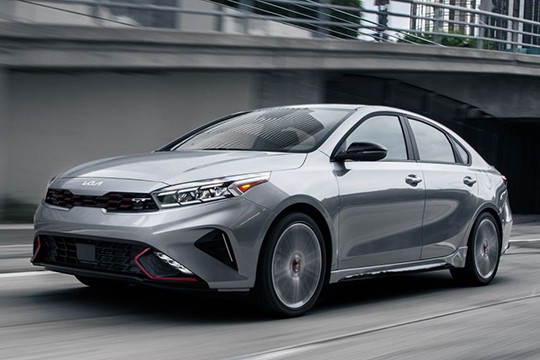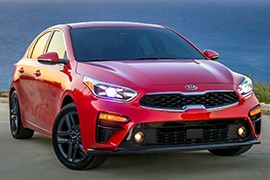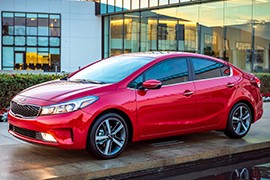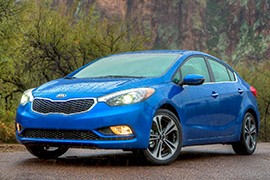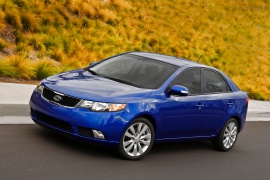KIA Forte Models/Series Timeline, Specifications & Photos
First production year: 2009
Engines: Gasoline
Kia refreshed its small-segment sedan contender, the Forte. When Chevrolet and Ford axed most of their lower-priced sedans, the Korean carmaker charged ahead and brought premium features in a class where the price was the most critical selling point.
The Korean carmaker introduced the facelift for the Forte's third generation in 2020 for the 2022 model year. Even though it was during the world pandemic situation, Kia tried to keep its promises to its clients. With a refreshed front fascia that featured narrower headlights, with an option for LED foglights, depending on the trim level. Also, it included redesigned LED taillights. The carmaker added new light-alloy wheels with 16" and 17" sizes for the drivetrain, depending on the trim level.
Inside, all versions received a new TFT instrument cluster that replaced the analog-dial system featured on the 2018 model year. An 8" or 10.25" touchscreen was installed on top of the center stack, depending on the trim level. Kia also offered a Harman Kardon sound system, usually found in premium vehicles. Kia added a set of leather-wrapped front bucket seats with red logos embroidered on the seatbacks for the newly introduced GT trim level.
All Forte versions came fitted with six standard ADAS (Advanced Driving Assistant Systems) and up to 15 available as an option for the safety department.
Under the hood, the carmaker offered the Forte with a choice of two engines, which provided 147 hp and 201 hp, respectively. A six-speed manual was fitted as standard, while a seven-speed automatic (dual-clutch) was available as an option.
The third generation of the Forte was introduced at the 2018 North American International Motor Show and it included cues inspired by the Stinger.
The Forte was the Elantra's sibling built by Kia and designed by Peter Schreyer. The Forte was launched as a 4-door sedan or a 5-door fastback, featuring the same shape as the Hyundai Elantra Fastback from other continents. Thus, the two twin vehicles covered most of the body versions for the compact segment, apart from a station-wagon and a convertible.
The sedan version of the compact Forte was the Kia equivalent for the Elantra, but with a sportier look. The headlights design showed the inspiration from the Stinger. The “tiger-nose” grille was already a signature design for the Kia brand and it was successfully applied on the Forte as well.
Inside, the Forte featured a spacious interior, due to an increase in the cabin height and a longer wheelbase than its predecessor. In order to receive higher grades from the IIHS, even the base model was fitted with features such as automatic emergency braking and active lane control. Adaptive cruise control, blind-spot monitors, and automatic high-beam headlights were optional. For the infotainment system, an 8” touch-screen display was on the options list.
For the powertrain, the 2018 Forte sedan was offered with only one engine in Atkinson Cycle mated to a 6-speed manual for the base model, or a CVT (named IVT by KIA) for the rest of the trim level.
The last facelift for the second generation of the Kia Forte was launched in 2016 as a 2017 model. A year later the entire generation was changed. Thus, the modification over the non-facelift version was minimal.
It takes an expert eye to notice the differences between the 2015 and 2017 model year, especially from the rear. On the front, the headlights were different, with a longer “tail” extended on the front fenders. The taillights though, had the white reverse lamp on the bottom, while the non-facelift version had that lamp in the middle, like a horizontal white line. The new taillights were available with an option of LED.
Inside the 2017 Forte, the differences are for the trims equipment. All versions received a drive-mode select, which improved the engine response according to the driver's need for comfort, economy or sportiness. The safety features had Autonomous Emergency Braking, Front Collision Warning, Lane Change Warning, Blind spot detector, and Rear-Cross Traffic Alert.
Strangely, the former 1.8-liter engine was replaced with a 2.0-liter Atkinson cycle engine, which was mated to either a six-speed manual or a six-speed automatic. The Atkinson engine is known for its efficiency, but only under certain circumstances which can hardly be achieved by a regular driver with a stick-shift gearbox. The 2017 Forte sedan was the first vehicle build by Kia in the new factory in Monterrey, Mexico.
Kia challenged the small-sized sedan segment with the Forte when it introduced the third generation of this nameplate in 2012 at the Los Angeles Auto Show.
Playing in the same league as the Civic and the Corolla was not easy for the Korean automaker. But still, it didn’t want to lose its grip on a segment of buyers who were more concerned about what they’d get for their money than what the resale value of their vehicle was. That’s why Kia made the Forte with an excellent warranty program that overtook its competitors. Even if it lacked the brand awareness of Honda and Toyota, the Korean car manufacturer tried to compensate for that with plenty of standard options for the Forte.
At the front, the Forte featured the same European-inspired design language created by Peter Schreyer for Kia. The big grille sported the Tiger-nose element with its pinched upper and lower sections. Its wide, swept-back projector-beam headlights looked organic, with curved lines ending in sharp angles at their top. Lower, on the apron, customers could order the Forte with a pair of fog lamps that flanked the front fascia. Kia offered generous chromed areas on and around the prominent grille to make the Forte look more up-scale.
From its profile, the ascending waistline created a dynamic look for the Forte, while the short and the alloy wheels emphasized it. The chromed surroundings for the windows line and the black B-post suggested a coupe-like vehicle, although it was a four-door sedan. Furthermore, Kia placed sculptured door panels to make the Forte look like a fast car. Finally, at the back, the automaker installed corner-mounted LED taillights that were extended from the rear quarter panels onto the trunk lid. At the launch, Kia offered the Forte in two trim levels: LX and EX.
Inside, Kia made a neat-looking interior that looked more expensive than it was. The soft materials and the clean layout of the dashboard looked upscale. In front of the driver, the instrument cluster featured large dials for the speedometer and tachometer, which flanked a 4.2-inch display that showed information from the car’s onboard computer. The EX trim level also included Kia’s UVO infotainment system, fitted with a touchscreen and featured navigation. At the front, the narrow seats were good enough for the daily commute, and the same went with the rear split-folding bench. The trunk offered 14.9 cu-ft (422-liter) of space, which was good for the car’s segment.
Under the hood, the Korean automaker installed a choice of 1.8- and 2.0-liter engines. The former was paired with either a six-speed manual or a six-speed automatic, while the latter was offered exclusively with the six-speed auto box. Thanks to the McPherson struts up front and the dual torsion beams in the back, the Forte provided enough comfort for its customers.
The surprisingly good looking Kia Forte continued the brand’s revival with its launch in 2009.
The Forte featured lots of elements characteristic to more expensive cars, but was at the same time among the least expensive small sedans on the market.
The Forte had a smooth clean look from the front and from the back, with the trim proportions being just right.
The cabin of the Forte gave an upscale feel with the tall roof and the wider body that offered great room for the passengers.
Headroom and legroom were good for the front passengers, however, the legroom in the back seats was limited.
Standard features included bluetooth, an auxiliary input jack, steering wheel controls and voice activation.
With one of the biggest trunks for its class, the Forte could’ve easily been a great companion on longer journey. For longer items, the rear seats could be folded to extend the load area.
The Forte was an inexpensive car to drive, and even if the engines offered were not the most powerful, the Forte was agile and had a good fuel consumption.
The hydraulic steering was decent, however, it was a little stiff at lower speeds and got lighter with higher speeds, which was not exactly the correct setup.
The sportiest Forte was available in the SX trim level, with a 2.4-liter engine that developed 172 hp.
The safety features offered were standard across the trim levels and included dual airbags, full side curtain airbags, ABS with brake assist and electronic stability control.
